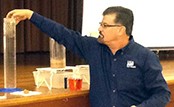Agronomy, Conservation, Homepage Slider, Water Quality
2020 Ohio No-till Council’s Winter Conference
By Dusty Sonnenberg, CCA, Ohio Field Leader: a project of the Ohio Soybean Council and soybean checkoff
The 2020 Ohio No-till Council’s Winter Conference went virtual this year, however the line-up of speakers, along with award and scholarship recipients was just as dynamic as ever.
Hans Kok, Program Director of the Conservation Technology Information Center began the event discussing the history of the soils in Ohio and Indiana.
“Understanding the history of the soils and what has been done to them over the last century helps to explain some of the environmental issues we see today,” Kok said. “We know a lot about soil physics and chemistry, but the biology of the soils is something we still don’t know a lot about. Data from the University of Illinois shows that we have lost about 80% of the organic matter in the soils that have been farmed continuously, in plots dating back to 1873.”
Kok discussed the importance of having a growing crop in the soil as often as possible.
“What we have been doing for the last century has been to grow corn and soybeans, and only use the land for about five months out of the year. The rest of the time it is baren,” Kok said. “When I went to school, I was told that the soil needs to rest between those crops, and that turns out to be absolutely wrong. Soil never rests. Soil is always living. You cannot turn it off. All that soil biology needs to be fed over the winter and taken care of. If we only grow crops for five months, Mother Nature sends us a signal that she doesn’t like that because she tries to get weeds to grow. By raising cover crops we can double the amount of time we have something growing in our fields and feeding the soil biology.”

Ratan Lal, OSU Distinguished Professor of Soil Science and recent World Food Prize recipient discussed the importance of soil carbon, and the potential for farmers to get paid for carbon sequestration as a commodity. He referenced the value of sequestered soil carbon at $130 per ton, and suggested that farmers who sequestered a half of ton of carbon in the soil or vegetation per acre could be paid $26 per acre per year.
Lal also advocated for Congress to take action and promote soil health by creating a “Healthy Soils Act” similar to the Clean Air act of 1967, and Clean Water Act of 1972.
“This would ensure agricultural sustainability and also ensure the rights of soil, just like any other living thing. The soil has a right to be managed, restored, protected, and judiciously used forever,” Lal said.
Jim Hoorman of Hoorman Soil Health Services gave an in-depth presentation about voles, which are a common pest found in fields with cover crops.

“Meadow voles and prairie voles are the most common ones we find in Ohio, and the ones that cause the most damage to our agronomic crops,” Hoorman said. “Voles represent almost 40% of all the mammals found on land.”
Voles have a very short gestation period, and can begin producing young shortly after weaning. Meadow voles can have four to eight litters per year, with up to 11 pups per litter. One meadow vole can have over 50 pups per year,” Hoorman said. “A field with voles will typically have 15 to 45 voles per acre. If they are really bad, there can be as many as 600 per acre. They really love alfalfa and bluegrass fields.”
Willie Durham, soil health specialist with the USDA-NRCS in Texas wrapped up the presentations with a discussion about nutrient cycling and the ability of roots to capture micro-nutrients. He explained the unintended consequences of tilled soil, and the reduction of soil aggregation. Durham explained the importance of soil biology and mycorrhizae, as well as water infiltration and the bacterial digestion and mineralization of soils.

Photo Credit UDSA NRCS
Durham concluded his comments discussing “glyphosate take all” and the toxic effects that glyphosate can have.
“When glyphosate is applied to resistant crops, it can be exuded through the roots, and ties up minerals within the soil. It is also toxic to things like pseudomonas bacteria. The pseudomonas bacteria help to reduce manganese and iron to a form that can be utilized by the crops,” Durham said. “The absence of the pseudomonas allows other forms of bacteria that are oxidizers, such as fusarium, to move in and replace the pseudomonas. These other bacteria further tie up nutrients.”
The Ohio No-till Council’s awards presented this year included the Educator/Researcher Award, presented to Dr. Rattan Lal; the Business/Industry Award, presented to Greenfield Ag; and the Outstanding No-till Farmer Award, presented to Gary Shick, farmer from Hardin County.
For more information on the 2020 Winter Conference, visit www.ohionotillcouncil.com for video recordings.